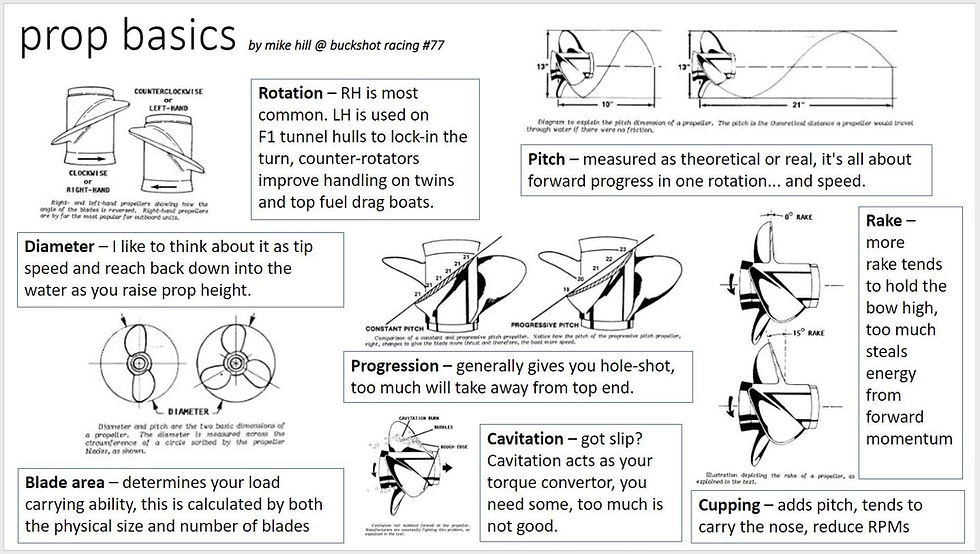The Science of Propellers: 8 Fundamentals of Prop Design
- Mike Hill
.JPG/v1/fill/w_320,h_320/file.jpg)
- Sep 7, 2023
- 3 min read
Updated: May 20

A high-performance boat propeller works by converting engine torque into thrust. Through the careful manipulation of water flow, the propeller blades are engineered to displace water efficiently—producing lift and forward motion in a manner that matches the hull characteristics and application of the boat.
When a propeller spins, it accelerates water rearward. This creates a low-pressure zone at the front of the propeller, drawing water in, while high-pressure water is ejected behind it. This pressure differential generates thrust—the core force moving the boat forward.
But thrust alone isn’t the full story. A properly designed propeller must also balance lift, especially when hull designs vary. For example, naturally lifting hulls like Tunnel or Mod VP styles require less lift from the propeller.
This allows more of the engine's energy to be dedicated to forward motion. In contrast, heavy v-bottom boats may need a prop that contributes more to vertical lift, helping get the boat onto plane efficiently.
Designing a winning stainless steel propeller blends both art and science.
However, eight key design elements define the engineering behind any performance propeller. Understanding these principles is essential for selecting, tuning, or developing the right prop for your needs:
1. Rotation
Most props are right-hand (RH) rotating. However, left-hand (LH) rotation is common in twin-engine setups and F1 tunnel hulls. Using counter-rotating props improves handling and balance, especially under high-speed or racing conditions.
2. Pitch
Pitch is the theoretical distance the propeller would move forward in one full rotation—like a screw in wood—assuming no slippage. Higher pitch typically equals more speed, but too much pitch can bog down acceleration or increase strain on the engine.
3. Diameter
The diameter is the distance across the circle the blades make during rotation. It impacts both the volume of water moved and the tip speed. Larger diameters can increase thrust and lifting force, especially when the prop is run higher on the transom.
4. Rake
Rake refers to the angle of the blades relative to the hub. More rake helps hold the bow of the boat higher, which is useful for high-speed performance. However, excessive rake can reduce forward efficiency and overload the engine.
5. Progression
This describes the change in pitch from the leading edge of the blade to the trailing edge. A progressive pitch design improves acceleration (hole-shot) while still delivering top-end speed. However, too much progression may reduce high-speed efficiency.
6. Blade Area
Blade area is determined by both the number and size of the blades. More area increases the ability to carry load, which is essential in heavy boats or high-drag situations. However, more surface area can also create more drag at high speeds.
7. Cavitation
Cavitation occurs when water vaporizes due to low pressure at the blade surface. A small amount of cavitation can aid performance—like a torque converter—but excessive cavitation reduces thrust and can damage the propeller over time.
8. Cupping
Cupping adds a small lip to the trailing edge of the blade. This increases effective pitch, helps lift the bow, and can reduce RPMs. It's particularly effective in improving bite in turns and preventing cavitation.
Conclusion
Understanding these eight core elements allows boaters, racers, and builders to tailor their propeller to match their boat, setup, and goals. Whether you’re chasing hole-shot, top-end speed, or improved handling, tweaking these design features can transform your performance on the water.








Comments